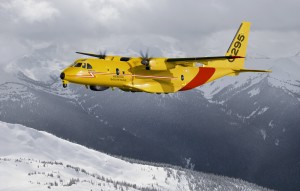Shortly before he moved to the new post of Justice Minister in this summer’s Cabinet shuffled, former Defence Minister Peter MacKay indicated that a request for proposal for the much-maligned fixed-wing search and rescue aircraft would be issued by the end of the year.
One could certainly excuse the aerospace industry for a collective yawn about a program that is now almost a decade old, but surprisingly there was a flurry of activity during the annual CANSEC trade show in May.
Alenia Aermacchi reaffirmed its teaming agreement with General Dynamics Canada and DRS Technologies for the C-27J Spartan. GDC will integrate the mission systems and provide long-term in-service support while DRS will provide training services. Team Spartan then embarked on a cross-Canada tour in early July, stopping in Halifax, Montreal, Toronto, Sudbury and Vancouver to meet with and identify possible partners for the program.
“When we’re finished building our team, I am confident that our FWSAR offering will drive superior benefits to all parts of Canada,” said Ben Stone, president and CEO of Alenia Aermacchi North America. In line with the recommendations of the Jenkins report to support key industrial capabilities in Canada, Stone added: “Our approach to forming strong in-country partnerships includes transfer of meaningful work to all our Canadian partners.”
Not to be outdone, Airbus Military used the event to announce a teaming agreement with Discovery Air Defence Services for the in-service support component of its program. Airbus, which is offering a variant of its widely used C295, has already established partnerships with Pratt & Whitney Canada, CAE, L-3 Wescam and Vector Aerospace. (Airbus and Montreal-based Pratt & Whitney recently marked the delivery of the 250th PW127G engine, which is used in the C295.)
Paul Bouchard, president of Discovery Air, also linked the partnership with the Jenkins report, saying the two companies have been “able to negotiate the type of arrangement for the transfer of high-value work” that the government is advocating.
Only Viking Air was left to ponder its prospects when MacKay appeared to pour water on the company’s offer to revive the current fleet of DHC-5 Buffalos while it builds a new generation of the venerable aircraft. In a June interview with Aviation Week, MacKay said the proposal by Viking and its partner Field Aviation to recertify the Buffalo might make it a developmental aircraft and thus “a bridge too far,” though he stressed the government, through the FWSAR secretariat, would hold an open and transparent competition.
Betting on simplicity
Since the summer of 2009, the government has hosted numerous consultation workshops and industry days, the most recent in the fall of 2012. Antonio Rodriguez-Barberan, senior vice-president commercial for Airbus, says there has been a distinct “improvement in the last couple of years” to the procurement process.
“We have seen a very positive change in attitude,” he said. “The dialogue between industry and the several ministries involved is very fluid. We have been able to express our ideas and we realize those ideas have been taken into consideration. ”
That includes Airbus’s long-held contention that speed should not be the primary factor in a future FWSAR aircraft. “For some time the concept for search and rescue was speed. We did not agree with that,” Barberan said, suggesting that Canada, in fact, has at least three distinct SAR missions, from maritime to Arctic to mountain, and more often slow speeds and sensors are the critical assets. “At the end, search has to be performed at very low speed, especially in the Rocky Mountains. And if you are over the sea, you need to have high technology mission systems, and on that we are probably the best in the world.”
If options on aircraft basing are part of the requirements, Airbus could propose a solution that would improve response time, he said. Canada’s size, terrain and weather pose some unique challenges, but with over 600 aircraft now sold in 16 countries, Barberan suggested the C295 is already performing the SAR mission in locations and climates that mirror Canada’s needs.
When the C295 was first designed, the company made a “bet on simplicity, on having reduced costs,” Barberan added.”The fuel consumption is probably half of one of our competitors. Our plane does not use a single special tool. All the tools to maintain our planes are standard. You can go to any place in the North where there is an aeronautic mechanic and the plane can be repaired.”
With the government seeking greater Canadian content, Airbus insists the aircraft is already more than 20 percent Canadian, starting with the P&W engines and CAE simulators. And, as part of its IRB plan, the company would seek to integrate other Canadian suppliers into the global Airbus supply chain rather than build a small fleet in Canada.
“We strongly believe that in this procurement, acquisition cost and lifecycle costs should have very important weight,” Barberan emphasized. “[The government is] not asking for an aircraft, [it is] asking for a solution…[and] we believe we have the right solution.”
